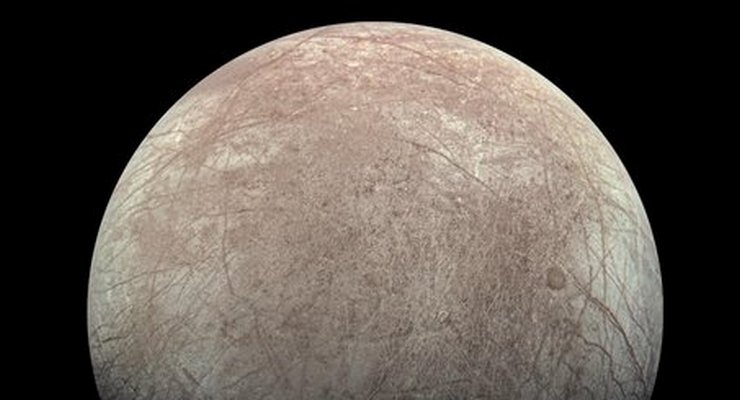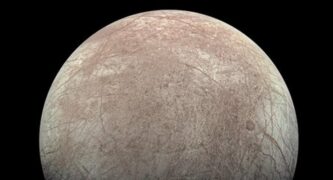
This view of Jupiter’s icy moon Europa was captured by the JunoCam imager aboard NASA’s Juno spacecraft during the mission’s close flyby on Sept. 29, 2022. Credit: Image data: NASA/JPL-Caltech/SwRI/MSSS Image processing: Kevin M. Gill CC BY 3.0
Europa, one of Jupiter’s icy moons, is a world of wonder and intrigue. Beneath its frozen surface, a vast ocean of liquid water may harbor the ingredients for life. Above it, the bombardment of charged particles from the giant planet constantly replenishes a thin atmosphere of oxygen and hydrogen.
But how much oxygen is there, and where does it come from? These are some of the questions that scientists at Jet Propulsion Laboratory are trying to answer with the help of Juno, a spacecraft that has been orbiting Jupiter since 2016.
Juno is not just a mission to study Jupiter. It is also a mission to explore its moons, especially Europa, which has fascinated researchers for decades. Juno is equipped with a camera called JunoCam, which captures stunning images of the moon’s surface features, such as cracks, ridges, and craters. JunoCam is not a scientific instrument but a public engagement tool that allows anyone to process and share the raw images online.
One of the images taken by JunoCam during a close flyby of Europa on Sept. 29, 2022, shows a crescent view of the moon, with Jupiter looming in the background. The image reveals the contrast between the dark and bright regions of Europa’s surface, which are thought to be composed of different types of ice and minerals.
But JunoCam is not the only instrument that Juno uses to study Europa. Another one is JADE, or Jovian Auroral Distributions Experiment, which measures the energy and composition of charged particles in Jupiter’s magnetosphere. JADE can detect the ions that are created when these particles hit Europa’s surface and knock off atoms and molecules from the ice.
By analyzing the data collected by JADE, scientists can estimate how much oxygen and hydrogen are being produced at Europa and how they might affect the moon’s ocean and potential habitability. A new study, published on March 4 in Nature Astronomy reports the latest findings from JADE, which suggest that Europa’s oxygen production is much lower than previously thought.
According to the study, Europa generates about 26 pounds (12 kilograms) of oxygen per second, or about 1,000 tons per day. That is enough to keep a million humans breathing for a day, but it is far less than the estimates from previous models, which ranged from a few pounds to over 2,000 pounds per second.
The study’s authors, led by JADE scientist Jamey Szalay from Princeton University, explain that the discrepancy is due to the different assumptions and methods used by different models. Some models assumed that all the water molecules that are split by the charged particles are converted into oxygen and hydrogen, while others accounted for the possibility that some of the water molecules recombine or escape as neutral particles.
The JADE data, on the other hand, provide a direct measurement of the oxygen and hydrogen ions that are actually picked up by Jupiter’s magnetic field and carried away from Europa. This method is more reliable and accurate, but it also has some limitations, such as the dependence on the orientation of the magnetic field and the distance of the spacecraft from the moon.
The study also suggests that some of the oxygen produced at Europa could make its way into the moon’s ocean, either by diffusing through the ice or by being carried by plumes of water vapor that occasionally erupt from the surface. This could have implications for the chemistry and biology of the ocean, as oxygen is a key ingredient for metabolic processes.
However, the study cautions that the amount of oxygen that reaches the ocean is likely to be very small, and that other factors, such as the pH, salinity, and temperature of the water, may also affect the potential for life. Moreover, the study does not address the origin of the water that forms Europa’s ice and ocean, which is another crucial question for understanding the moon’s history and evolution.
Juno’s mission is not over yet. The spacecraft is expected to continue orbiting Jupiter until July 2025, and it will perform several more flybys of Europa and other moons, such as Ganymede and Io. Each flyby will offer a new opportunity to collect more data and images, and to refine the estimates of Europa’s oxygen production and other properties.
Juno is not the only mission that JPL is managing to explore Europa. Another one is Europa Clipper, which is scheduled to launch in 2026 and arrive at Jupiter in 2030. Europa Clipper will orbit Jupiter, but it will make dozens of close passes by Europa, using a suite of instruments to map the moon’s surface, measure its magnetic field, probe its interior, and search for signs of plumes and ocean.














 3 comments
3 comments


